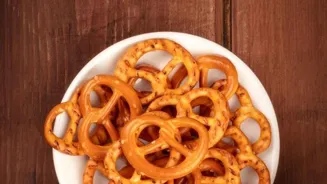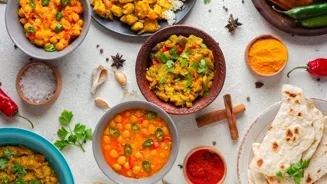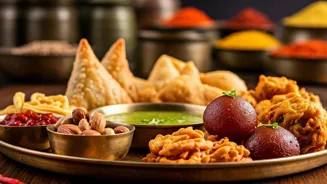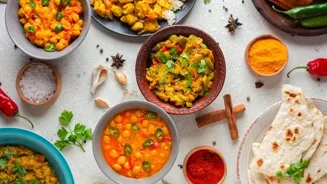Unearthing age-old, wholesome dishes rooted in tradition where millets nourished generations long before they became a superfood.
Millets, once the staple
food of rural India, have long been overshadowed by more mainstream grains like wheat and rice. However, with the growing recognition of their health benefits, millets are making a comeback in modern diets. These ancient grains are rich in fiber, vitamins, and minerals, and are known for their resilience in drought-prone areas. In rural India, where these grains have been cultivated for centuries, millet-based dishes were a common feature of daily meals, each region offering unique recipes passed down through generations. In this article, we explore some of the forgotten millet recipes that have been integral to rural Indian cuisine, shedding light on their nutritional value and cultural significance.
Ragi (Finger Millet) Roti: A Traditional Flatbread
One of the most commonly consumed millets in rural India is ragi, or finger millet. Known for its high calcium content, ragi has been a key component in the diet of many communities, particularly in South India. One of the simplest yet most beloved dishes made from ragi is ragi roti (flatbread).
To make ragi roti, the millet flour is mixed with water, a pinch of salt, and sometimes a dash of oil or ghee, then kneaded into a dough. The dough is rolled into thin discs and cooked on a hot griddle, resulting in a soft, hearty flatbread that pairs beautifully with lentil-based curries, yogurt, or chutneys. The high fiber content of ragi roti makes it an excellent choice for regulating blood sugar levels and promoting digestive health.
Bajra (Pearl Millet) Khichdi: Comfort Food of the Village
In the arid regions of Rajasthan and Gujarat, bajra (pearl millet) is a staple grain, often used in various forms to create wholesome dishes. One such dish is bajra khichdi, a nutritious and comforting meal that is often consumed during the cold winter months.
Bajra khichdi is made by cooking pearl millet with moong dal (yellow split lentils), turmeric, cumin, and other spices. The dish is hearty and filling, providing long-lasting energy, making it an ideal comfort food for farmers and laborers who need sustenance for long hours of work. In many rural households, it is served with a dollop of ghee, which not only adds flavor but also enhances the absorption of fat-soluble vitamins present in the dish.

Kodo Millet Porridge: A Nutritious Start to the Day
Kodo millet, also known as varagu or kodra, is a highly nutritious grain that is native to parts of central India. Traditionally, kodo millet was used to make a hearty porridge, known as kodo millet kanji, which served as a healthy breakfast for rural families.
To prepare the porridge, kodo millet is boiled in water with a pinch of salt and a dash of jaggery for sweetness. Sometimes, grated coconut or milk is added to enhance the flavor and texture. This simple dish is rich in iron, fiber, and antioxidants, making it a great choice for boosting energy levels and promoting overall health. Kodo millet porridge is especially popular in regions where this millet is grown in abundance, such as Madhya Pradesh and Maharashtra.
Sorghum (Jowar) Bhakri: The Rural Delight
In the dry and semi-arid regions of India, especially in Maharashtra, Gujarat, and Madhya Pradesh, sorghum (jowar) is a staple food. One of the traditional ways to enjoy jowar is in the form of bhakri, a round, thick flatbread.
Jowar bhakri is made by mixing jowar flour with warm water and kneading it into a dough. The dough is then rolled into a thick, rustic flatbread and cooked on a hot griddle. It is often served with a variety of accompaniments like yogurt, pickles, or a simple lentil soup (dal). The slightly nutty flavor of jowar pairs well with spicy curries or vegetable dishes, making it a versatile and filling meal. Packed with protein, fiber, and essential minerals like iron and magnesium, jowar bhakri is a great option for those looking to maintain a healthy diet.
Little Millet Upma: A Wholesome Breakfast Dish
Little millet, known as samai in Tamil and Saamai in Telugu, is another millet that is widely used in rural Indian kitchens. One of the popular ways to prepare little millet is by making upma, a savory breakfast dish that is easy to prepare and highly nutritious.
To make little millet upma, the millet is first roasted and then cooked with mustard seeds, curry leaves, green chilies, ginger, and chopped vegetables like carrots, peas, and beans. The upma is seasoned with salt and garnished with fresh coriander leaves. Little millet upma is a great source of fiber, antioxidants, and B-vitamins, making it an ideal breakfast to kick-start the day.
Foxtail Millet Pongal: A Traditional South Indian Delight
Foxtail millet, known as thinai in Tamil, is commonly used in South India to make a variety of dishes. One such dish is foxtail millet pongal, a savory dish often enjoyed for breakfast or as a light meal. Similar to the traditional rice-based pongal, foxtail millet pongal is made by cooking the millet with moong dal, black pepper, ginger, and curry leaves, and then tempering it with ghee, cashews, and mustard seeds.
The dish is fragrant, flavorful, and provides a healthy alternative to rice-based pongal. Rich in protein and fiber, foxtail millet pongal is easy to digest and offers a steady release of energy throughout the day. It is especially popular among health-conscious individuals who seek gluten-free and nutrient-dense alternatives to conventional grains.
Revival of Millet Dishes
While millets were once a central part of the rural Indian diet, they have gradually been replaced by more mainstream grains. However, with the growing awareness of the health benefits of millets and the need for sustainable agriculture, there has been a resurgence in millet consumption. These grains are not only more drought-resistant and environmentally friendly than rice and wheat, but they also provide a range of health benefits, including better digestion, improved blood sugar regulation, and a reduced risk of chronic diseases.
The revival of traditional millet recipes offers an opportunity to reconnect with India’s rich culinary heritage while also promoting a healthier and more sustainable way of eating. Whether enjoyed as part of a savory dish, a hearty porridge, or a rustic flatbread, millets continue to play a significant role in rural kitchens and are gaining popularity in urban areas as well.












